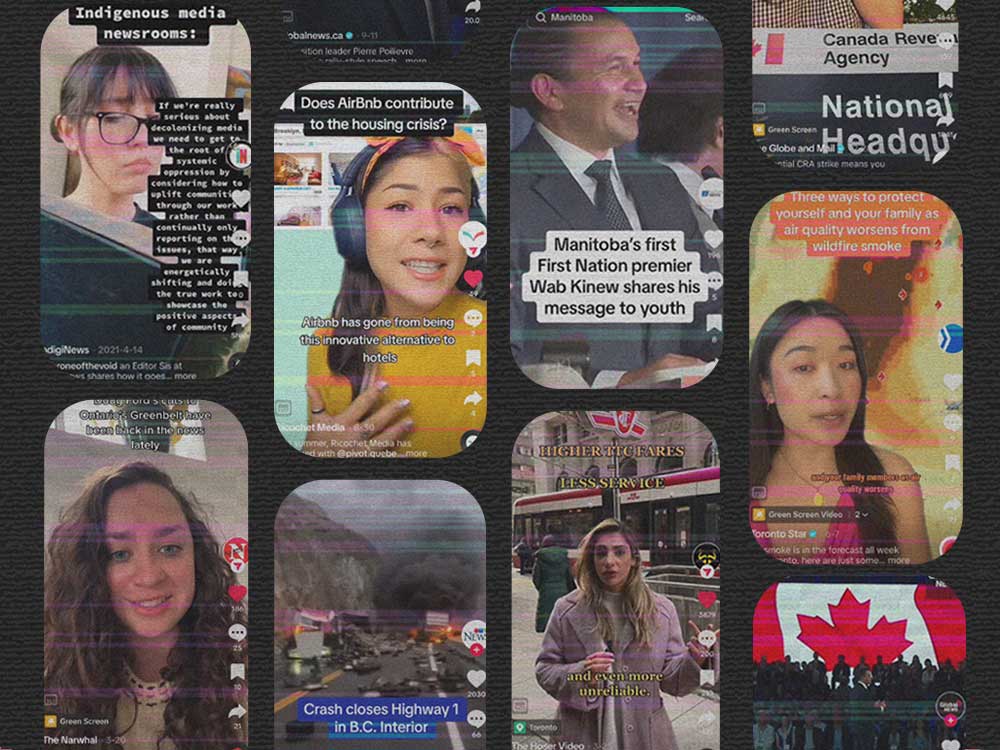Many young people can’t fight the urge to scroll TikTok first thing in the morning. But for CBC’s Ashley Fraser, it is part of her job.
Example: when Ozempic officially entered the cultural zeitgeist earlier this year for its apparent success at helping some people achieve weight loss, a purported alternative named berberine, advertised as “nature’s Ozempic,” went viral for reportedly decreasing hunger. Hyping the option were people like Isabelle Lux, a TikTok creator with more than half a million followers, who said on screen: “I’m not kidding, I was stuffed all day.”
Fraser, CBC News’ TikTok producer, stitched Lux’s video into her own, narrating with the confidence of an anchor: “Like most things too good to be true, some doctors say this claim is too.”
Fraser’s TikTok video goes on to feature clips of interviews with a family physician, a naturopath and a weight loss expert who each explain the difference between the drug and the supplement and in doing so debunk the idea that Ozempic and berberine have the same effect on the body.
Fraser’s video amassed more than 50,000 views. But the comment section is still full of users saying berberine worked for them.
“18 lbs in 6 weeks. It works.”
“All I know is that I am eating less and not that hungry.... So explain that to me?”
“I’m on ozempic. Can I take berberine also?”
Welcome to the booming era of TikTok. What started out as a cringeworthy place for gen-Zs to post videos of themselves dancing has become a forum for examining scientific health questions and other big issues. The app is disparaged for its free-flowing disinformation, potential ties to China’s regime and privacy risks to users — and is also beckoning to news organizations competing for audiences.
TikTok was a perfect distraction while many quarantined in the early months of the COVID-19 pandemic. But the app has since exploded in popularity with its opportunities for monetization and trending livestreams. Many now are even using it to replace Google as a search engine.
TikTok’s user interface is the perfect rabbit hole. Users can scroll through countless vertical videos without the time spent ever appearing on the screen. It’s easy to let hours go by consuming anything from makeup and cooking tutorials to esthetically pleasing morning routines to comedy skits and standup clips to intellectual video essays.
The appeal wasn’t lost on competitors. Similar versions of TikTok’s setup were quick to appear on other competing social media sites — see Meta’s Reels, found on both Instagram and Facebook, as well as YouTube Shorts.
As video proves a hot commodity for storytelling, news media decision-makers can be forgiven for scratching their heads; just a few years ago, many outlets followed Facebook’s urging to “pivot to video,” a move that failed to attract big enough audiences to pay for the content. Then it surfaced that Facebook reported allegedly exaggerated numbers over how much time viewers were consuming video. Many newsrooms saw a pivot to layoffs.
Moving on after Meta’s news ban
Journalism outlets in Canada have a new reason to take a close look at TikTok’s success and ask themselves whether they should invest in making quick-hit videos for that platform. Namely, backlash to the Online News Act by Meta and Google, who are resisting the law’s requirement that they pay news providers for news content shared on their platforms. Instead, Meta is preventing Canadian news organizations from posting news on its sites, and Google is making noises about a similar ban in Canada.
Pivot to TikTok then? There seems room. A Reuters study suggests news on TikTok “is still mostly generated by social media influencers, activists or ordinary people rather than by journalists.” And because “many worry about the credibility of the information they see there,” that leaves a space newsrooms theoretically could — and should — fill.
Some U.S.-based outlets such as the Washington Post and the New York Times have made use of TikTok by using comedy skits or viral sounds to tell a news story. WaPo has even posted ads, suggesting some revenue has been achieved.
You’ll find Canadian newsrooms showing up on TikTok, too. The Reuters study found 55 per cent of Canada’s top publishers have an account and publish regularly. Those include CityNews with more than 304,700 followers, CTV News at 278,400 followers and the Toronto Star with more than 60,000 followers.
Still, it’s not at all clear how news outlets can measure the return they get on such investments.
Monetizing TikTok at a level that pays for serious reporting is a hard nut to crack. Yes, TikTok offers its Creator Fund and other revenue programs to eligible creators based in the U.S., Italy, Spain, the U.K. and other select countries. But it appears Canadian TikTok accounts still have very limited opportunity to make much revenue on the app.
One reason journalism outlets pour effort into any social media platform is with the hope new readers will see a headline, click on the link taking them to the news site and even come back for more. But metrics for how successful TikTok has been in converting viewers to actual readers are elusive.
For reader-supported publications, like The Tyee, that’s a problem. Why spend a bunch of money cranking out videos if it doesn’t earn reader loyalty?
“Most newsrooms are experimenting, particularly newsrooms interested in younger people,” said Nic Newman, lead author of the Reuters study. But it remains a question of reach more than revenue. “[Newsrooms] don’t want to invest resources in something that then becomes unpredictable, or never produces money, which is obviously the history of platforms in Canada and elsewhere.”
“It’s a place you have to be if you want to attract younger audiences — but there’s no money.”
That has some news organizations drawing a different lesson from the Online News Act backlash by Meta and Google. Instead of shifting to other platforms, they are asking: Should we just stop being so reliant on social media platforms to connect with audiences?
TikTok’s coveted audience
Ricochet Media is an independent, online journalism site whose audience includes a large percentage of younger people. When Andrea Houston became Ricochet’s managing editor in April 2022, she put getting a TikTok account off the ground on her to-do list. Then a fellow from the Journalists for Human Rights BIPOC youth program joined the team, launched the account and got the content rolling. But after the fellow left, Ricochet Media’s small team focused on other priorities and published only a smattering of TikToks.
What did Houston learn? She observed many young people, including journalism students, participating in the comments section of TikToks Ricochet published.
“Students are looking for ways to get around the stodgy old Facebooks and Twitters that are getting blocked or shut down,” said Houston.
In March, Ricochet posted a TikTok covering the RCMP’s raid at the Gidimt’en checkpoint on the Wet’suwet’en First Nation’s traditional territory, where land defenders protested against the construction of the Coastal GasLink pipeline. Many users in the comments section wrote “Boost,” commonly used to help push the video in TikTok’s algorithm, or “Thank you for holding space.”
While Ricochet builds a new website, Houston does not have access to the analytics on the traffic TikToks brought to the site, she says. But she is convinced some had impact. “When I see people commenting, ‘thank you for standing on the corner on scene’ or ‘thank you for letting me know that this is happening,’ or people responding with ‘miigwech’ or ‘hiy hiy,’ that to me is the marker of success.”
Houston says cross-platform connections not only drive traffic but also drive interest and extend reach. “That beats any analytic number you can show me.”
At Canada’s public broadcaster, the goal is to reach people in Canada where they’re at — including on the third-party platforms they don’t own or control, says Andree Lau, CBC News' senior director of digital publishing and streaming. “Like most media outlets, we need to grow our younger demographics.”
The CBC doesn’t find TikTok a significant source for referrals back to its site, says Lau. But the social media site is a space for building awareness, trust and establishing CBC News “against that sea of disinformation.”
CBC News can, however, survey readers on how they arrived at a CBC News article to get an idea of whether TikTok played a role. “You could measure: ‘Are you a TikTok user?’ ‘Yes.’ ‘In the last month, did you go to a CBC News story? How did you get there?’” explained Lau. But a black-and-white number indicating exactly how many TikTok viewers became regular CBC News readers is more difficult.
Privacy and disinformation concerns
Right now, TikTok is one of the least trusted social networks for news, says Newman, partly because “it’s a bit of a free-for-all.” The far-right website Rebel News is thriving on TikTok, for example, with over 39,000 followers and many videos getting tens of thousands of views. And disinformation around the Kenyan presidential election last year was rife on TikTok.
Seeing how much Facebook and Instagram had become such a big part of people’s daily lives, CBC News decided it was important to be intentional with new platforms such as TikTok. “That’s why we ended up deciding that this needed to be fully resourced with a dedicated person to do it authentically,” Lau said.
Given the CBC’s annual budget is vastly larger than, for example, The Tyee’s, it may seem CBC funding TikTok content is an easy call. No, says Lau. “I know it seems that we are big and well-resourced, but we also exponentially have many more demands.” Putting money into TikToks is highly strategic, she argues. “At the end of the day, this is part of our survival, right?”
Like Ricochet, CBC News confirmed it has yet to see any revenue from TikTok. But Lau says its investment is “worth it as long as we are able to continue to reach and engage with people in Canada.”
Earlier this year, Canada banned TikTok on government-issued devices, joining various other governments such as the U.S. and the European Union. “On a mobile device, TikTok’s data collection methods provide considerable access to the contents of the phone,” reads a February statement from the Treasury Board of Canada Secretariat. There are also concerns that TikTok’s China-based parent company, ByteDance, might provide the Chinese government access to sensitive user data such as location information.
ByteDance has maintained TikTok is not China-owned and does not share information with the government.
Agencies and Crown corporations that don’t fall under the federal government's Policy on Service and Digital were “strongly advised” by the treasury board to consider following suit by banning TikTok on work devices, reported the CBC in March. Several Crown corporations such as the Bank of Canada did voluntarily decide to leave TikTok.
But not the CBC.
Lau says that CBC News has had conversations about TikTok’s privacy concerns but cannot share details of those conversations.
In other news, TikTok was recently fined about C$500 million for other privacy concerns: making accounts automatically public when teens signed up, allowing anyone to view or comment on their content.
Richochet’s Houston says her team is gauging the trade-offs that come with pouring more time and resources into TikTok.
“To be honest, I wonder about the ethics and safety of all social platforms right now,” said Houston. “I have serious concerns about how dependent we are on them; especially as independent media is increasingly squeezed and starved.”
Should TikTok become a go-to news source for a new generation, Houston thinks we may be heading down a frightening path made familiar by other social media platforms. “There is so much room here for mis/disinformation and opportunity for censorship.”
A ‘kaleidoscope’ of social networks
A big challenge facing newsrooms like Houston’s and Lau’s is that the audience for news has fragmented dramatically in the past decade, as Digital News Report author Newman points out.
As social media options multiply, many journalism organizations have increased their focus on strengthening their direct contact with readers through podcasts, emailed newsletters and other venues. Most youth aren’t using these avenues, notes Newman, save for the more educated and well-off ones who tend to sign up for podcasts.
“We’ve seen a switch into video networks; we’ve seen a switch away from friend-based networks, where you follow a particular person, to content-based social networks, which have a social element to it like YouTube or TikTok,” explained Newman.
In other words, social media is no longer serving up content based on the people users know, but rather what the larger human hive makes most viral. And creating short videos with the best chance of going viral isn’t necessarily what fact-based, sober-minded news outlets are built to produce. They can spend a lot of money trying, and failing, to gain the kind of attention that impresses TikTok’s algorithm.
Additionally, video networks don’t often feature spaces providing links to news websites. TikTok wants to keep you on TikTok. “So it’s an even worse deal,” noted Newman. Newsrooms spend on creating videos but when they are posted on TikTok or YouTube, “you can’t get traffic referred to the website.”
What advice, then, does Newman have for today’s beleaguered journalism outlets? Especially those caught in the quagmire triggered by Canada’s Online News Act?
“Most publishers are realistic about short-term revenue opportunities on TikTok. The reason they’re doing it is to build that relationship with younger people over time, hopefully take them on a journey.
“If we can start a relationship, if people get to know our brand and what we do, then later when they get to a stage when they have enough money to buy a news subscription, then maybe they’ll consider us.”
A tough fit for news
When Ricochet’s Houston looks at TikTok today, she thinks about Twitter in 2010, when citizens, including journalists, used it as a telegraph to share ideas, tips and information in real time.
Over the last decade, however, online harassment and hate against journalists has become a real problem for Twitter. “There was a time when Twitter was the place to share links, establish journalists’ credibility and make connections,” said CBC’s Lau. “But over the years, we saw that the amount of harm and toxicity there increased against journalists and news outlets, and so that, at some point, outweighs the return on being on those platforms.”
As a result, many journalists have pulled back their Twitter participation, notes Lau. “You’re always monitoring for considerations from privacy to legal to harm, both to the public and to our staff.”
Meta’s sudden banning of news content is another reason Houston and her Ricochet colleagues cast a wary eye on TikTok, even as they create content for the platform. “Do we want to invest in a platform that might not exist in a couple years?” she asked. “What’s been happening on Facebook is a really important lesson that we can’t depend on these social media platforms.”
Part of the problem is that news organizations are trying to graft their craft onto platforms that weren’t designed with them much in mind, says Houston. Ricochet is having fun thinking about how to tell stories in new, creative ways. “But at the end of the day, we aren’t influencers. We are investigative journalists, and we know TikTok was not invented for this purpose.”
The short-form video format is here to stay, Newman is convinced. And we can learn a lot from it in terms of compelling storytelling. But even as TikTok entices with its mesmerized, scrolling legions, tread carefully, he suggests.
Apps will do one thing really well, says Newman, then “try to become the ‘everything app,’ like what’s going on with Twitter. Then they lose their way a bit and people fall out of love. I imagine TikTok will end up there.”
This article is part of an occasional series on how Canadian media became intertwined with major tech platforms, and how it’s affecting Canadians and their access to journalism.
If you want to stay in direct contact with The Tyee, sign up for our free newsletter. ![]()
Read more: Media, Science + Tech


















Tyee Commenting Guidelines
Comments that violate guidelines risk being deleted, and violations may result in a temporary or permanent user ban. Maintain the spirit of good conversation to stay in the discussion and be patient with moderators. Comments are reviewed regularly but not in real time.
Do:
Do not: